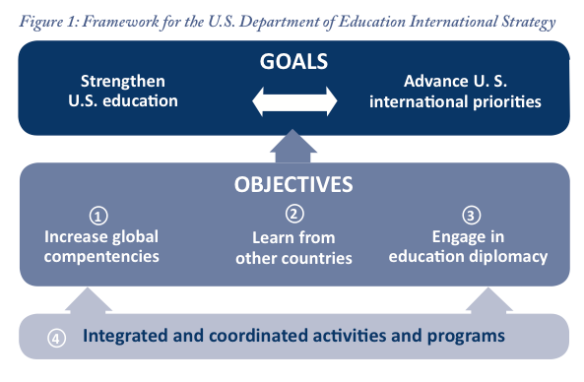 This month, the International Affairs Office of the US Department of Education released its new strategy document, Succeeding Globally Through International Education and Engagement, which:
This month, the International Affairs Office of the US Department of Education released its new strategy document, Succeeding Globally Through International Education and Engagement, which:
… outlines the U.S. Department of Education’s International Strategy for 2012-16 and affirms the Department’s commitment to preparing today’s youth, and our country more broadly, for a globalized world, and to engaging with the international community to improve education. It is fully integrated with the Department’s domestic agenda and designed to simultaneously attain two strategic goals: strengthen U.S. education and advance our nation’s international priorities.
The strategy document lists four objectives:
Objective 1: Increase the global competencies of all U.S. students, including those from traditionally disadvantaged groups;
Objective 2: Enhance federal, state and local education policy and practice applying lessons learned from other countries to drive excellence and innovation in the U.S. and abroad;
Objective 3: Advance U.S. international priorities in strategically important countries through active education diplomacy; and
Objective 4: Develop, monitor and continuously improve ED’s international activities in an integrated and coordinated manner.
The concept of “education diplomacy” is one that the Connect All Schools consortium has championed at the classroom level. So, too, the idea that internationalizing US classrooms advances our national security, while strengthening our overall education system. The strategy document, however, does not mention the role that technology can play in attaining the Department’s two strategic goals. It’s a conspicuous oversight considering that US Department of Education’s 2010 National Educational Technology Plan highlighted that teaching and learning was becoming increasingly global, networked, personalized and mobile, and called for more investment in preparing administrators, teachers, students and parents for globally networked, personalized “anytime, anywhere” learning. The Department also highlighted the role of technology in internationalizing education in August during Connected Educators Month. In fact, the US Department of Education launched International Education Week in 2000 with the US Department of State specifically to promote “the wise use of technology internationally.”
It is difficult to conceive of how the US Department of Education will effectively support education diplomacy—which it calls a “core element” of its work—without using modern technologies or supporting educators to use modern technologies effectively in their classrooms. For example, the strategy document calls for increasing international exchanges, but it makes no mention of virtual exchanges, which are increasingly seen as a powerful new tool to scale diplomacy and cross-cultural understanding, especially for traditionally disadvantaged groups and children too young to travel abroad.
Still, the strategic document is another step forward from the US government in advancing the idea that ALL young people should experience international collaboration as part of their education. And, the commitment by the US Department of Education to “walk the talk” and collaborate closely with their peers globally is important. Why is both classroom and government-level education diplomacy critical? Simply,
… so that we have a nation, and a world, that is informed, engaged, and prepared to deal effectively with the global challenges that will face us.

Pingback: Introducing the Christopher Stevens Youth Network « iEARN-USA
Pingback: Engaging the Global Commons | BAIL: Bay Area International Link